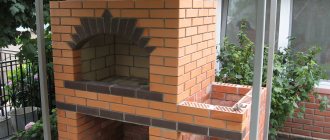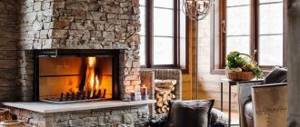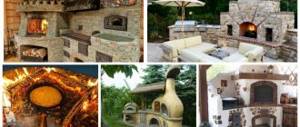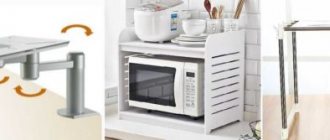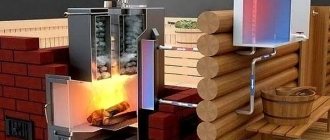Features of the design of dropper furnaces
Such units consist of a rectangular or cylindrical body. Inside there is a combustion chamber, in the lower part of which there is a container intended for waste oil and holes that provide air flow.
After heating, the fuel evaporates, and then the vapors combine with the air in the chamber. The resulting mixture as a result of convection is directed upward through the firebox, where, when burned, it releases a significant amount of heat.
If desired, a water or air heat exchanger is built into the upper part of the drip furnace during processing, as a result of which it becomes possible to heat the room more evenly and better or to arrange a circuit for supplying hot water.
Drip supply occurs through a metal tube, which is connected to an oil evaporator. Its second end is brought out and connected to the tank with a flexible hose. In the upper compartment of the drip-type furnace during exhaust there is a smoke pipe, which is connected to the chimney.
The temperature in the upper part of the unit, even with a heat exchanger, is not low, so the chimney system must be installed in accordance with fire safety regulations. Experts do not recommend making such a design in an open version, since the oil can ignite.
Supercharged furnace design
A pressurized homemade stove for testing is a closed cylindrical vessel, inside of which there is a well-known afterburning chamber in the form of a pipe with holes. At the bottom of the vessel there is a door for access to the firebox and ignition. The chimney pipe is welded to the top of the cylinder, and forced air is supplied into a pipe with holes through the top cover or a simple insert through the side wall.
Used oil is located at the very bottom of the vessel and is supplied automatically as needed. The supply methods can be different: from a container with a submersible pump or through a float mechanism, whichever you prefer. The figure above shows a diagram of a stove with air injection, a water jacket and fuel supply using a float valve.
The used oil at the bottom of the container is ignited by adding a small amount of gasoline or solvent, then the blower fan is turned on. After warming up, the fuel begins to actively release vapors that are burned with excess oxygen. As a result, a powerful flame is formed, spreading in all directions, as can be seen in the photo.
Advice. This furnace design has one peculiarity: from a strong flame, the bottom of the vessel becomes red-hot. When you need to heat one room, a fan is placed outside opposite this zone. If we are talking about heating a house, then the stove is equipped with a water jacket.
The combustion products leaving the furnace body have a very high temperature (sometimes up to 400 ºС), as in the previous case. In order to prevent the release of heat and increase the efficiency of the unit, the chimney must be equipped with a water heat exchanger connected to the heating system through a storage tank. Then you can achieve a furnace efficiency of about 80-85%.
What are dropper stoves made of?
Due to the fact that this type of unit has a simple structure, you can assemble a drip-type stove with your own hands from a sheet of iron, a gas cylinder and a used barrel. The only requirement for them is the presence of a wall with a thickness of at least 4 millimeters, otherwise the body will move during operation. A proven drawing of a furnace using a gas cylinder will help you assemble the furnace correctly and quickly.
The simplest and at the same time reliable way is to assemble a stove from a gas cylinder, since it has a durable body and can withstand high pressure and heat to high temperatures.
In addition, its dimensions are suitable for a unit capable of heating a garage, workshop or small country house. If you carefully weld such a stove, it will turn out to be safe, it can be easily cleaned and heated.
Popular options for pre-fabricated furnaces, their characteristics
The Teplamos NT-612 stove is often chosen as a device used for heating a garage. The power of such a drip fanless heater can vary between 5-15 kW. Fuel consumption is 0.5-1.5 l/hour.
Related article:
Pellet boilers: prices and characteristics of models from different manufacturers
What is a pellet boiler? Installation of pellet boilers. Types of pellet boilers. Tips for choosing. Review of prices for pellet boilers.
This furnace for use in a garage is a closed type device. It is equipped with a chimney, an air supply pipe and a built-in tank designed for 8 liters of fuel. Fuel combustion occurs in the inner chamber. The operation of the device begins with electrical heating of the plasma bowl. When the required temperature is reached, fuel is supplied and air is forced into the combustion chamber. The average cost of the device is 30 thousand rubles.
Important! For normal operation of the stove, it must be preheated with a small amount of diesel fuel, which is poured into a special bowl.
Another popular model is the Zhar-25 (MS-25) stove. This device can operate not only on waste oil, but also on diesel fuel. The device operates from the electrical network, which powers the internal fan. The thermal power of the furnace varies from 25 to 50 kW. It is designed to heat a room up to 500 square meters. m. Maximum fuel consumption is 4.5 l/hour. The device has large dimensions. Its weight reaches 130 kg. This stove needs to be equipped with a good chimney. You can buy it for 45 thousand rubles.
The exhaust furnace is equipped with a chimney, an air supply pipe and a built-in tank
Do-it-yourself stove made of sheet metal and pipes
Depending on the type of device, the structure can be created from pipes of different diameters or from iron sheets. To work you will need the following tools:
- grinder with cutting and grinding wheel;
- sheet metal and pipes;
- welding machine and electrodes;
- metal corners;
- metal paint that can withstand high temperatures.
Before making a furnace for testing, a detailed drawing of the apparatus is made. You can create it yourself or use ready-made options that are easy to find on websites on the Internet.
The first step is to make the lower part of the chamber connecting to the fuel tank. It looks like a rounded or straight tank with a lid where two pipes are located. The first is used to supply oil, and the second is used to strengthen the pipe that goes into the middle part of the device. Elements for the tank are cut out with a grinder and connected according to the drawing.
Depending on the type of device, the structure can be created from pipes of different diameters or from iron sheets
The bottom and metal corners are welded to the walls of the tank, which act as the legs of the structure. To create a lid, a sheet of metal is taken and holes are made in it. The first, with a diameter of 100 mm, is located in the center; the second, 60 mm in size, is located closer to the edge. The lid should be removable, which will make cleaning the stove easier.
A pipe about 37 cm long and 100 mm in diameter is used to supply oxygen. It has holes along the entire length of the element necessary for the supply of oxygen. The pipe is welded perpendicular to the cover at the bottom of the apparatus. An air damper is fixed on it, which will be secured with a rivet or bolts. The hole under the damper should be 6 cm in size. It is intended for supplying oil and igniting fuel.
The design of the upper tank is carried out by analogy with the design of the lower tank according to the drawing of a furnace using waste oil with your own hands. The walls of the product must have a thickness of at least 350 mm. A bottom with a diameter of 10 cm is cut out of the bottom of the tank, which should be placed closer to the edge. A small piece of pipe with a diameter of 11 cm is welded to the bottom of the hole. This is necessary to connect the element to the gas combustion tank.
Before making a furnace for testing, a detailed drawing of the apparatus is completed
Since the top cover of the supercharged exhaust furnace is exposed to high temperatures, a metal sheet with a thickness of at least 6 mm should be used for its manufacture. There is an opening in the lid for the chimney pipe, which should coincide with the opening at the bottom of the container. Between these elements, a partition made of dense metal sheet is mounted, located near the smoke hole. A pipe is attached to the top of the lid, connecting to the chimney part. The self-production process can be seen in detail in the video of the furnace being tested.
Important! To give the structure rigidity and stability, a metal spacer in the form of a piece of pipe with a diameter of 200-300 mm is welded between the chambers.
Materials
To assemble a drip furnace with your own hands, you need to prepare:
- used 50-liter gas cylinder with a whole body;
- a two-meter metal pipe with a diameter of 100 millimeters with a wall thickness of at least 3.5 millimeters;
- for the heat exchanger and other small parts - the remains of an equal-flange metal corner with a thickness of 40–50 millimeters;
- a sheet of 4 mm steel or its trim of the required size;
- cast iron brake disc from a car, can be used;
- a regular-sized freon bottle with a needle valve;
- half-meter half-inch metal pipe;
- a hose of the required size, which is suitable for attaching to a ½-inch pipe and clamps;
- half-inch ball valve;
- door hinges and fire door latch.
In addition, pipes of a certain cross-section and a duct fan are needed to assemble an air heat exchanger. You can use a corrugated pipe or components for the chimney. To ensure a high-quality result, you should use drawings of a stove from a gas cylinder during testing.
A simple model of a gas cylinder stove
The peculiarity of the homemade device is that petroleum products are supplied by drip method. This is convenient because oil consumption is reduced. In addition, they are safe, which is why they have gained considerable popularity. Another advantage is the availability of the materials that are used.
Prices for popular models of welding machines
Welders
To make the same heating device, you will need the following tools:
- welding machine;
- drill, metal drill for it;
- Angle grinder, to it - cutting and grinding wheels;
- paint, which is then used to paint the outside of the body.
Type of finished oven
Special heat-resistant paints have been developed for stoves. It is better to use products for t° 400-650°C. Such paints do not melt or deform. Silicone, zinc and aluminum contribute to durability. Among them are Celsite, Certa.
You can also make thermal paint yourself. Recipe:
- construction liquid glass - 0.5 l;
- silverfish - 0.2 kg;
- ground chalk - 0.02 kg.
The components are mixed. If the paint turns out to be too liquid, add a little more chalk.
Heat-resistant enamels are used to cover the outside of the case
Prices for heat-resistant enamels
Heat-resistant enamels
To assemble the furnace itself, take:
- gas cylinder 50 l - 1 pc.;
- loops;
- steel pipe with a diameter of 10 cm - 2.4 cm;
- valve and a small piece of 0.5 inch pipe;
- steel sheet (4 mm) - 50 cm²;
- clamp - 2 pcs.;
- steel corner 5 cm - 1.20 m;
- a cast iron brake disc of a car, which would fit freely in the cylinder;
- hose;
- freon cylinder for the fuel tank.
Attention! Before you start working with the cylinder, the valve must be opened and stopped overnight. This is an additional safety measure that will prevent an explosion if the gas is not completely used.
Assembly sequence
Table 2. Furnace assembly
| Photo | Description |
| A hole is drilled in the bottom. The drill is lubricated with oil so that sparks do not form upon contact with the metal of the cylinder. The container is filled with water and then emptied to remove the gas stored there. The same is repeated after cutting the container. |
| Two openings are cut in the cylinder body: in the lower part, approximately half as high as in the upper. |
| In order to build the bottom of the upper chamber, a circle is cut out of a sheet of steel, slightly smaller than the diameter of the container. A 10 cm round hole is made in the center. |
| A 20 cm piece is cut from the prepared pipe and numerous holes are drilled for oxygen access. The inside of the pipe, which acts as a burner, is well polished. |
| The burner is welded to the previously made bottom of the upper compartment. |
| Install the structure into the cylinder. |
| The bottom is attached to the bottom of the brake disc by welding, as shown in the figure. The disk should be made of cast iron, since this material tolerates high temperatures well. |
| A fuel tray is made. A lid is welded to the top of the disk. An opening is left in the structure - air flows through it for normal draft. |
| They make a coupling that will connect the pan and the pipe. To do this, use a pipe of slightly larger diameter, which is first cut longitudinally. |
| A hole with a diameter of 0.5 inches is drilled in the lower part of the housing, where the oil combustion chamber will be located. |
| One end of the pipe is cut with an oblique cut, inserted into the hole and welded on the outside. |
| The tube is connected to a valve, at the other end of which there is a hose connecting the stove to the fuel supply tank. |
| Remove the valve and neck from the top of the body. Instead, a pipe with a diameter of 10 cm is welded. |
| A heat exchanger is made, which is installed between the burner and the chimney - in this area the temperature is highest. To do this, a metal plate is welded inside. Another purpose of this part is to distribute the flame more evenly. |
| The swirler is made from a steel sheet and installed. |
| A duct fan is installed on one side. |
Upon completion of the manufacture of the waste oil stove, the chimney is removed to the street. The pipe can be brought out through a specially made hole in the wall. To eliminate the risk of fire, a metal sheet is attached to the wall. It would be a good idea to use a fireproof glass when crossing the chimney pipe. Near the installation site of the stove, the walls are covered with iron, and a piece of the plate is placed on the floor.
Exiting the chimney outside through the wall
If the room uses water heating, then the heat exchange unit discussed above is not necessary. Then several parallel connected coils are passed through the upper chamber. However, this will require the installation of additional equipment - a fan, a circulation pump.
Doors
Done, weld the doors. They are made from pieces of metal that have been cut from the body. A slot is cut in the bottom door. This is necessary to ensure that air can freely enter the oven.
Hole in the door of the lower chamber
The doorway in the upper chamber is reinforced with fire-resistant plates. This will ensure the chamber is sealed. As already mentioned, hazardous substances are formed at this stage of combustion. To ensure tight closure, a reliable lock is also installed here - for example, like the one in the photo below.
A lock on the top door ensures the chamber is sealed
Making a fuel tank
The fuel tank is made from a freon cylinder. Before starting the rework, you need to make sure that there is no freon left in the cylinder, and the vessel itself is not under pressure.
Important! For fuel, take a cylinder in which the needle valve is working. This part will help to properly control the amount of oil that is poured into it.
A hole is made in the lower part of the freon cylinder through which used oil will be poured inside.
The hole through which used oil is poured into the cylinder
A hose, one end of which is connected to the valve, is connected to the tank at the other end. A hole is made in the container itself, through which it is then planned to feed oil into the oven.
Connecting the freon tank to the hose
How to use a stove from a gas cylinder?
The rules for using the device are the same as for standard ovens. Oil is poured into the pan so that the bottom is covered with a layer. Then a piece of foam rubber is soaked in gasoline and placed on a tray so that the lower end is in the fuel.
After this, carefully open the valve that is connected to the oil tank. The stream entering the furnace must be very thin.
Attention! Even when the oven begins to operate stably, it is necessary to check the layer of oil on the bottom from time to time.
Stopping the oven is also easy. The valves are simply closed. First, the oil supply stops, and then the device body gradually cools down.
Video - Self-made waste oil stove
Work on preparing the cylinder
Even after prolonged ventilation, condensation remains in the gas cylinder. To remove it, you need to remove the valve and gearbox and leave it in fresh air for several days.
Then a hole is drilled in the bottom of the cylinder. To prevent sparking, the drill is moistened with oil. Since it is not easy to make a hole in thick metal, it is better to start the work with a small diameter drill, and then it can be increased to 10–16 millimeters.
Next, the balloon is filled with water and drained after 24 hours. Since condensate has an unpleasant, pungent odor, it should be carefully poured away from your home. The procedure is repeated if necessary.
Stove body
A drawing will help you create a furnace using a gas cylinder.
The work is performed in a certain sequence:
- The balloon is visually divided into two parts, the upper one should be 2/3 of the height, and the lower one should be 1/3. Openings are cut out in each, the width of which is approximately equal to 1/4 of the circle.
- To make holes, use a grinder. You need to make the cut as even as possible. Subsequently, pieces of metal are used to make doors.
- To remove any remaining condensation, the cylinder is additionally washed from a hose with water under pressure.
- The dropper furnace compartments are separated during processing using a metal insert. It is cut to the size of the cylinder from sheet steel.
- The resulting circle will serve as the bottom for the exhaust vapor combustion chamber. It will be large in volume, which will allow you to use firewood or briquettes to fire the unit and, if necessary, burn household waste in it. The bottom is tried on and adjusted to the desired size.
- To make the burner, a 20-centimeter piece of pipe with a cross-section of 100 millimeters is used. Holes with a diameter of 10 millimeters are made in it using a drill and a metal drill. They need to be staggered around the entire circumference to the middle of the burner. The inside of the pipe is polished without leaving burrs.
- The burner is placed in the bottom of the upper part, having welded the joint with a welding machine.
- The completed part is mounted in the unit body between the chambers with the perforated part downwards. The holes are needed for air suction.
- To make a working tray that serves as the bottom of the lower chamber, use a brake disc of the required size. A plug cut from a 4-mm sheet of metal is welded to its bottom to close the hole.
- The top cover with an opening is made from the same sheet. Its shape should allow the counterpart of the burner to be welded, providing air access.
- When assembling a drip-type furnace with your own hands, the bottom of the burner from a piece of 100 mm pipe 10 centimeters long is connected to the lid by welding.
- To connect the parts of the burner, use a coupling, which you can make yourself from a 100 mm pipe, cut lengthwise and slightly bent. The coupling allows you to make the burner detachable. It will be possible to lift it, remove the pan, clean it of oil and remove soot from the top of the chamber and burner.
How to make?
Any home craftsman who knows welding techniques and techniques can easily and quickly produce this simple unit. First, you should prepare materials, focusing on the drawings of a furnace operating on waste oil:
Following such a detailed guide, all that remains is to take and assemble the prepared parts. To work you will need a standard set of tools and accessories:
- welding machine;
- angle grinder;
- drill with a set of drills;
- a set of metalwork tools;
- measuring devices.
Upon completion of assembly, it is important to check both containers for leaks and the quality of welds, since oil waste can leak through the smallest defects and pores over time. It’s not difficult to do this yourself; there are many ways. You can coat the seams with kerosene and determine the presence of defects visually, or soap the joints and supply compressed air inside the tanks.
To heat medium-sized rooms, the power of an oil furnace needs to be increased; the simple design proposed above will not be enough. Using this principle of operation, power cannot be increased indefinitely, but there are still options. For example, a furnace with two afterburning chambers, a separate fuel tank and a retractable firebox, as shown below:
Waste oil supply
Fuel is supplied to the self-assembled drip furnace during production from an external tank using an adjustable dropper. In this case, it is used as a used freon cylinder, which must have a working needle valve.
The sequence of the process of how to make a drip for a stove is as follows:
- In the freon cylinder, in the lower compartment, a hole is made of such a size that it is convenient to pour waste into the structure from any container. If desired, a coarse mesh is placed on it. The tank must be located above the unit, so a special bracket is welded to its body. The hose is connected to the cylinder valve with a clamp.
- A hole is cut out in the housing on the mounting side of the oil tank; its diameter should correspond to a half-inch pipe for feeding waste, which will need to be fixed.
- Having cut a piece of pipe of a certain length, a thread is cut at one end, and the other is cut off under such a knot so that a stream of oil falls directly into the opening of the pan.
- The pipe is welded to the body, and the resulting seam is cleaned.
- A ball valve is screwed onto the end of the threaded tube. During the assembly process, a squeegee with an oil hose is connected to it.
Waste oil furnace: operation
Before purchasing such a design, it is recommended to understand the principle of operation. Regardless of whether the installation is factory installed or done by yourself, the operation will be the same:
- the device consists of several tanks - upper and lower, which are connected by a perforated pipe;
- the shape of the tanks is often represented by a cylinder or rectangle;
- the design is such that the upper container is slightly offset relative to the lower container;
- the device contains a chimney, an afterburning chamber, a damper, legs, as well as a nozzle; the kit may include a control panel and instructions;
- works due to pyrolysis combustion of heavy fuel - the lower tank is half filled with the mixture, then ignited using gasoline or solvent;
- gasoline burns, the fuel heats up, rises with vapor, and heat begins to flow.
The efficiency of the process can be adjusted with a damper; the oil consumption during operation of this safe unit is 2 liters per hour at maximum heating and 0.5 liters per hour when maintaining the temperature.
Photo: Furnace in operation
How to heat with waste oil
To avoid emergency situations during operation, it is recommended to take all precautions when firing the unit. For example, you should not leave the product in a draft, and it is also undesirable to place other objects near the device.
Expert opinion
Igor Lebedev
Expert of our site. More than 10 years in the furnace business. Implemented dozens of different projects. Helps make the content of our site interesting and useful!
Ask a Question
Important! If the rules are not followed during combustion, condensate formed from evaporation may fall down. An installation operating on an oil mixture may then malfunction due to the formation of an explosive mixture inside the container.
It is advisable to use only a technical mixture for fuel; the unit heats up in 5 minutes. Liquid is poured into the lower reservoir to fill 2/3 of the tank, then a little gasoline or solvent (20-30 grams) is added. Using a wire and wick, carefully set fire to the mixture and wait until it warms up. The principle of operation involves the formation of a stable flame, which is fueled by oxygen. In versions with blowing, adjustment of combustion intensity occurs faster.
Don't miss: Do-it-yourself Russian oven and mini oven: step-by-step instructions, drawings and order (+ best Photo projects)
Heating devices are great for garages, greenhouses, homes, and car repair shops. There are also industrial options on sale, which are used for heating industrial premises and spacious warehouses. The most effective device designs allow you to heat a room to a comfortable temperature in a short period of time.
Heat exchanger
For a drip-type furnace, this element is not mandatory. When the room is small and without partitions, then the heat coming from its walls is sufficient for heating. If it is necessary to achieve greater efficiency of the unit, an air or water type heat exchanger is made. It is placed in the upper chamber.
A heat exchanger is made from a section of 100 mm pipe. Its length should be such that the ends protrude beyond the walls of the housing by 10–20 centimeters on both sides. Two holes are created at opposite ends of the cylinder, a pipe is passed through them and fixed by welding.
A flame divider made of a sheet of iron must be welded above the heat exchanger so that it divides the flame into tongues, increasing heat transfer.
A swirler is placed inside the air heat exchanger, accelerating the air flow. It is made from a strip of steel or a corner divided into bent blades.
Then air ducts made from an uninsulated chimney pipe and corners are connected to the heat exchanger pipe. A duct fan is installed on one side of the air duct. It is connected to the network directly or through the contacts of a thermal relay installed on the fan housing, or by adjusting the temperature mode.
Ignition and operation
It is not easy to light a cold drip stove during testing. The fact is that oil vapors can only burn when heated, so the unit is ignited using other flammable substances - alcohol or gasoline. They need to be poured into a pan in a thin layer on top of the oil and then set on fire.
When burning, the substance heats up the top layer of waste, and it evaporates. After this, the oven begins to function. Then open the valve on the waste supply hose and adjust its flow into the furnace. To stop the unit, close the valve.
To clean the structure from soot and soot, use metal brushes or fine gravel, which is thrown into the chimney. He, touching the walls of the chimney, knocks off the soot and it settles inside the firebox. After opening the door, sweep it out with a brush. The pan is removed and dirt is cleaned from it.
How to properly make such a hearth can be seen in the drawing of a drip furnace during development, which must be prepared before starting work.
Main types
In principle, a home craftsman can make a similar structure from:
- from metal sheets or a gas cylinder;
- design in which oil is supplied drop by drop;
- unit with auxiliary supercharging.
The simplest option is to use a gas cylinder (we will look at this design in more detail a little later), thick steel sheets or large-section metal pipes. It is more difficult to build a furnace that provides additional air pressurization - here, among other things, you will need to install a fan in order to supply air to compartment No. 2, in which fuel vapors are burned.
Thanks to the fan, the fuel mixture will burn more efficiently, and the generated heat will spread evenly and quickly throughout the heated room. Such designs are suitable for garages that need to be heated as quickly as possible.
It is extremely difficult to make a unit with drip fuel supply yourself. To do this, you need professionally made drawings (they can be found in the relevant literature or on the Internet), as well as appropriate knowledge in the field of heating equipment using waste oil. But if everything is done correctly, then you can acquire a small, economical and truly functional device with which you can heat a greenhouse, garage, etc.

